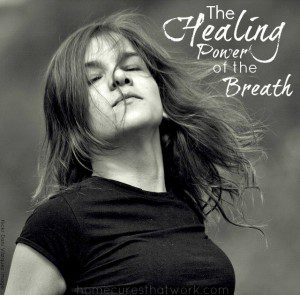Breathing Your Way Out of Anxiety
Breathing Exercises to Overcome Panic Attacks
by Rob Fischer
Suddenly, inexplicably Shawna found herself overcome with fear. She knew she didn’t like flying, but for some reason this flight sent her over the edge. They had just taken off and were experiencing some heavy turbulence as they climbed to altitude.
Her heart raced as sweat trickled down the small of her back. She couldn’t catch her breath. Her hands trembled so much that she gripped the armrests until her knuckles turned white. She had difficulty swallowing. Momentarily, she thought she might lose consciousness…
Anxiety, fear and panic are debilitating. They rob a person of their ability to respond to a situation rationally whether that situation is threatening or normal.
Often, when a person experiences a panic attack or acute anxiety, they feel like they can’t catch their breath. And the harder they try, the more difficult it becomes to breathe and the worse their panic attack spirals.
Dr. David Carbonell, Anxiety Coach, explains, “When you feel like you can’t catch your breath, it’s because you forgot to do something. You forgot to exhale. That’s right. Before you can take a deep breath, you have to give one away. Why? Because, when you’ve been breathing in a short, shallow manner (from your chest), if you try and take a deep inhale, you just can’t do it. All you can do is take a more labored, shallow breath from your chest.”[2]
Dr. Carbonell goes on to describe the “Belly Breathing Exercise” as a means to overcoming this common problem. Follow these guidelines to learn and master this exercise:[3]
- Place one hand on your belly, just above your waist and put your other hand on your chest over your breastbone. Your hands will provide you with biofeedback as you practice this exercise.
- “Open your mouth and gently sigh, as if someone had just told you something really annoying. As you do, let your shoulders and the muscles of your upper body relax, down, with the exhale.” Don’t completely empty your lungs, but relax the muscles of your upper body.
- Now close your mouth and relax for a few seconds.
- Keeping your mouth closed, inhale slowly through your nose by pushing your belly out. When you’ve inhaled a comfortable amount of air, stop inhaling.
- Pause briefly for whatever length of time you find comfortable. Because you’re taking larger breaths than you’re used to, it’s important that you breathe more slowly.
- Now repeat steps 2 through 5, establishing a rhythm to your breathing. Click here to view a short video demonstrating this breathing technique.
Shallow breathing contributes to anxiety and panic attacks. This practice of deliberate, deep breathing stimulates the parasympathetic nervous system (PNS), which helps place the body at rest.
Stress is at the core of most diseases and most of us live stressful busy lives which is commonly accompanied with shallow breathing. When we breathe shallowly, the body does not receive as much oxygen as it needs and it makes our muscles constrict. You can almost feel this tightening when you are stressed or tense. With deeper breathing you can turn the switch from high alarm to low in seconds. Furthermore, breathing deeply will increase the neurochemical production in the brain and release more of the ones that elevate moods and control pain.
We don’t usually think about breathing. Breathing, like our heartbeat, digestion, glands, and many other functions of the body are regulated by the autonomic nervous system. All of these functions are performed involuntarily and without thought. Among these, only breathing can be controlled voluntarily.[4]
 In their book, The Healing Power of the Breath, Richard P. Brown, M.D. and Patricia L. Gerbarg, M.D. explain, “By voluntarily changing the rate, depth, and pattern of breathing, we can change the messages being sent from the body’s respiratory system to the brain. Messages from the respiratory system have rapid, powerful effects on major brain centers involved in thought, emotion, and behavior.”[5]
In their book, The Healing Power of the Breath, Richard P. Brown, M.D. and Patricia L. Gerbarg, M.D. explain, “By voluntarily changing the rate, depth, and pattern of breathing, we can change the messages being sent from the body’s respiratory system to the brain. Messages from the respiratory system have rapid, powerful effects on major brain centers involved in thought, emotion, and behavior.”[5]
In addition to the belly breathing exercise above, another breathing exercise is called “Coherent Breathing.” This method calls for breathing at a rate of just five breaths per minute. You can achieve this rate by inhaling while counting to five and then exhaling also counting to five.[6] Again, this establishes a pattern of slow, deliberate breathing designed to calm the body and emotions.
Therese J. Borchard, associate editor for World of Psychology, writes, “Deep breathing has become increasingly important in my recovery from depression and anxiety because I recognize that shallow breath contributes to my panic.”
I would also be remiss in not telling you about Wholetones. Wholetones is a collection of therapeutic musical tones specially designed to put you at ease and alleviate anxiety and stress. These unique melodies can help your breathing rhythms and music itself is a powerful positive stimulant. You can listen to samples of these tunes online.
As Shawna tightly gripped the armrests of her seat on the plane, she remembered her breathing techniques. With difficulty at first, she closed her eyes and began slowly and deliberately exhalingdeeply while counting to five, and then inhaling through her nose also to the count of five. Miraculously, within just a few breaths, she found herself in control again.
You don’t have to wait until you have a panic attack to practice these breathing techniques. (I pray that you never have a panic attack!) We all experience fear and anxiety at times, often accompanied by that telltale shortness of breath.
Remember these breathing exercises. They can be part of a bedtime routine that promotes calmness and relaxation. This type of daily practice makes it easier to use the deep breathing technique when other situations arise. Then put them into practice when you’re feeling overwhelmed, stressed, or anxious and breathe your way out of anxiety!
If you liked this article, then you’ll love these:
- How to Reduce Anxiety and Stress with Meditation
- How to Take Control of Your Anxiety
- A 60 Second Solution to Panic Attacks…
 Rob Fischer has been writing professionally for over 35 years. His experience includes writing curricula, study guides, articles, blogs, newsletters, manuals, workbooks, training courses, workshops, and books. Rob has written for numerous churches, for Burlington Northern Railroad, Kaiser Aluminum, and Barton Publishing. He has also trained managers in effective business writing. Rob holds two Master’s degrees, both focused heavily on writing. Rob has published eleven books and serves as an editor and ghostwriter for other authors.
Rob Fischer has been writing professionally for over 35 years. His experience includes writing curricula, study guides, articles, blogs, newsletters, manuals, workbooks, training courses, workshops, and books. Rob has written for numerous churches, for Burlington Northern Railroad, Kaiser Aluminum, and Barton Publishing. He has also trained managers in effective business writing. Rob holds two Master’s degrees, both focused heavily on writing. Rob has published eleven books and serves as an editor and ghostwriter for other authors.
- Get link
- X
- Other Apps

I impressed by the quality of information on this website. There are a lot of good resources here. I am sure I will visit this place again soon.
ReplyDeletemagnetic therapy for anxiety